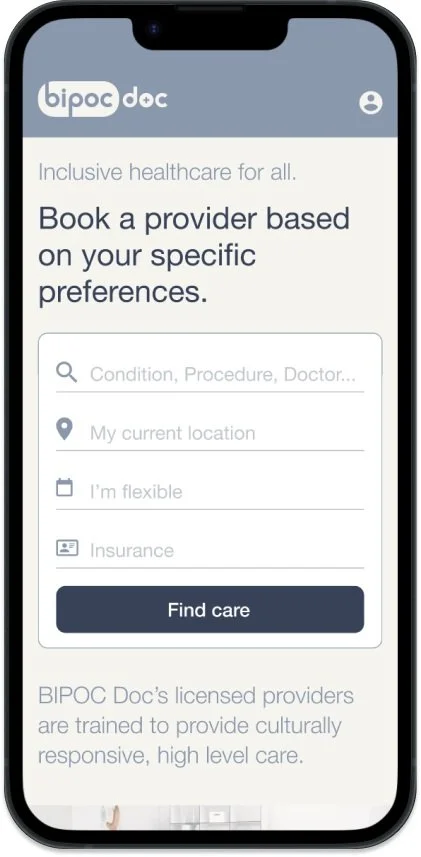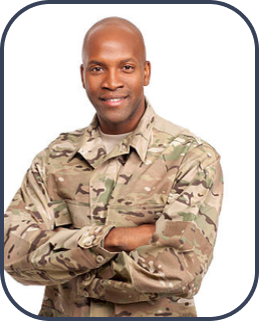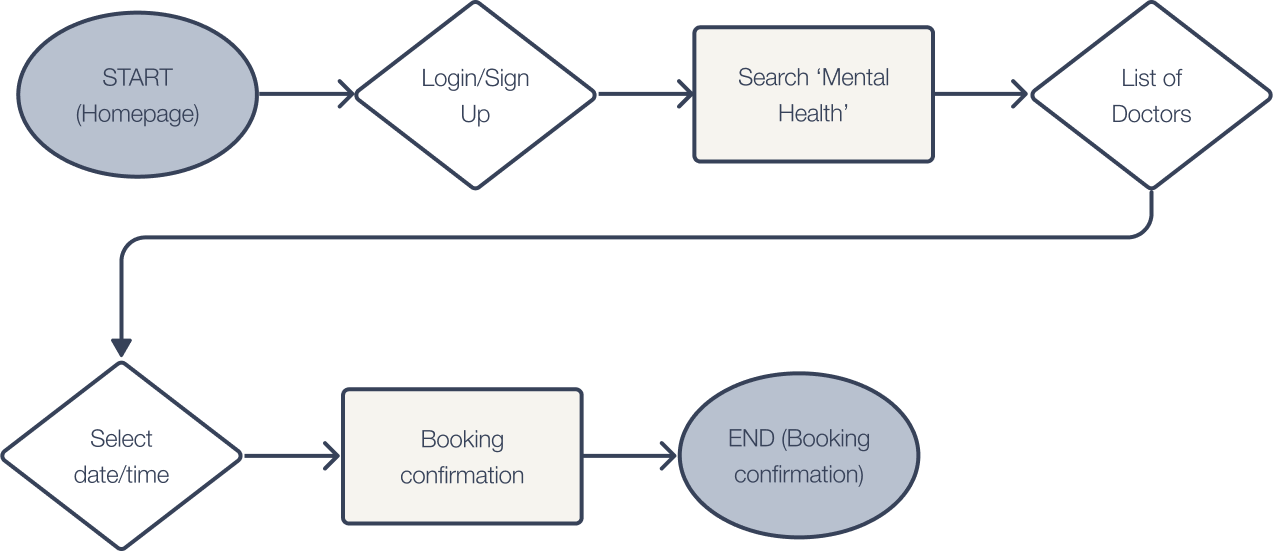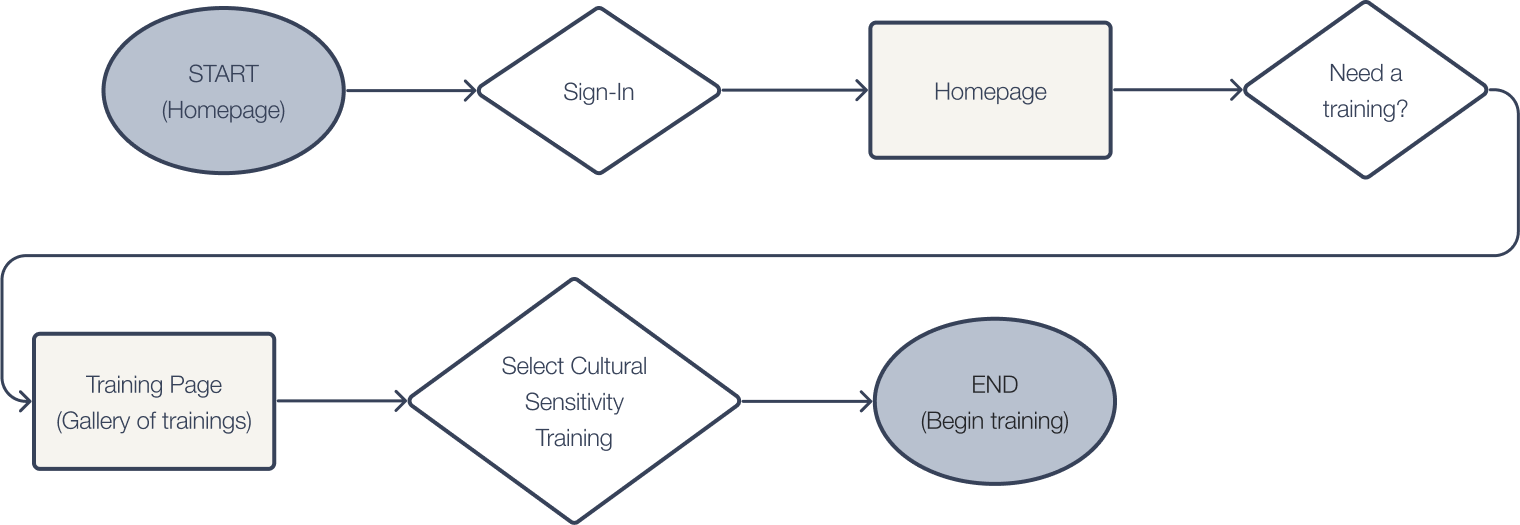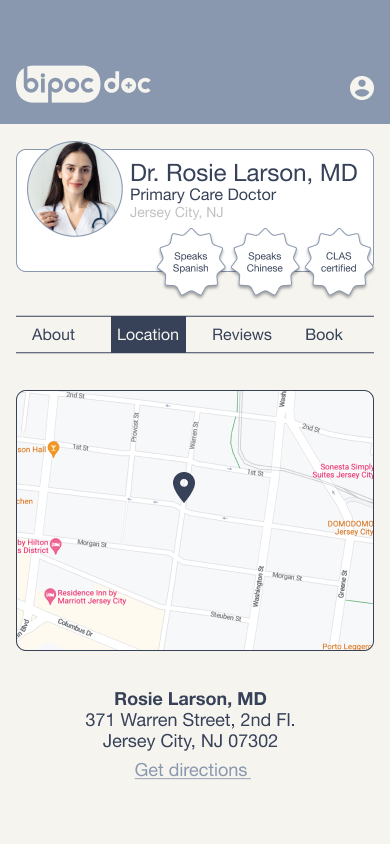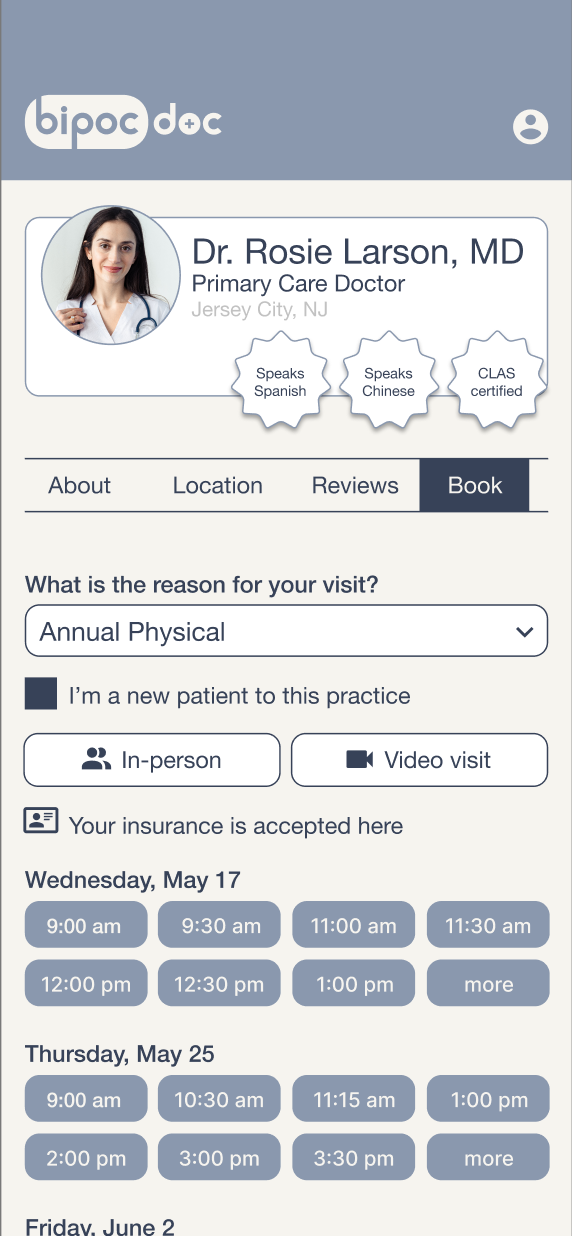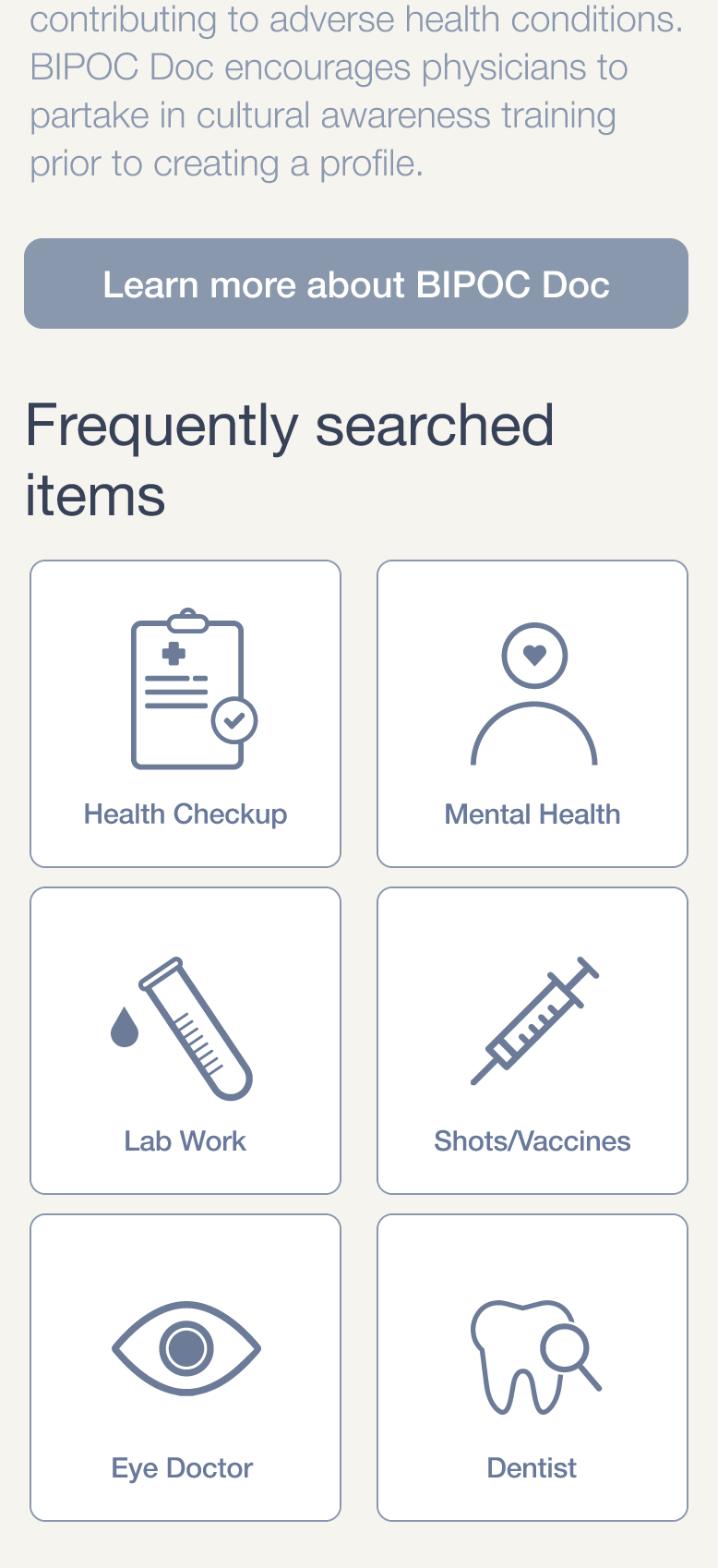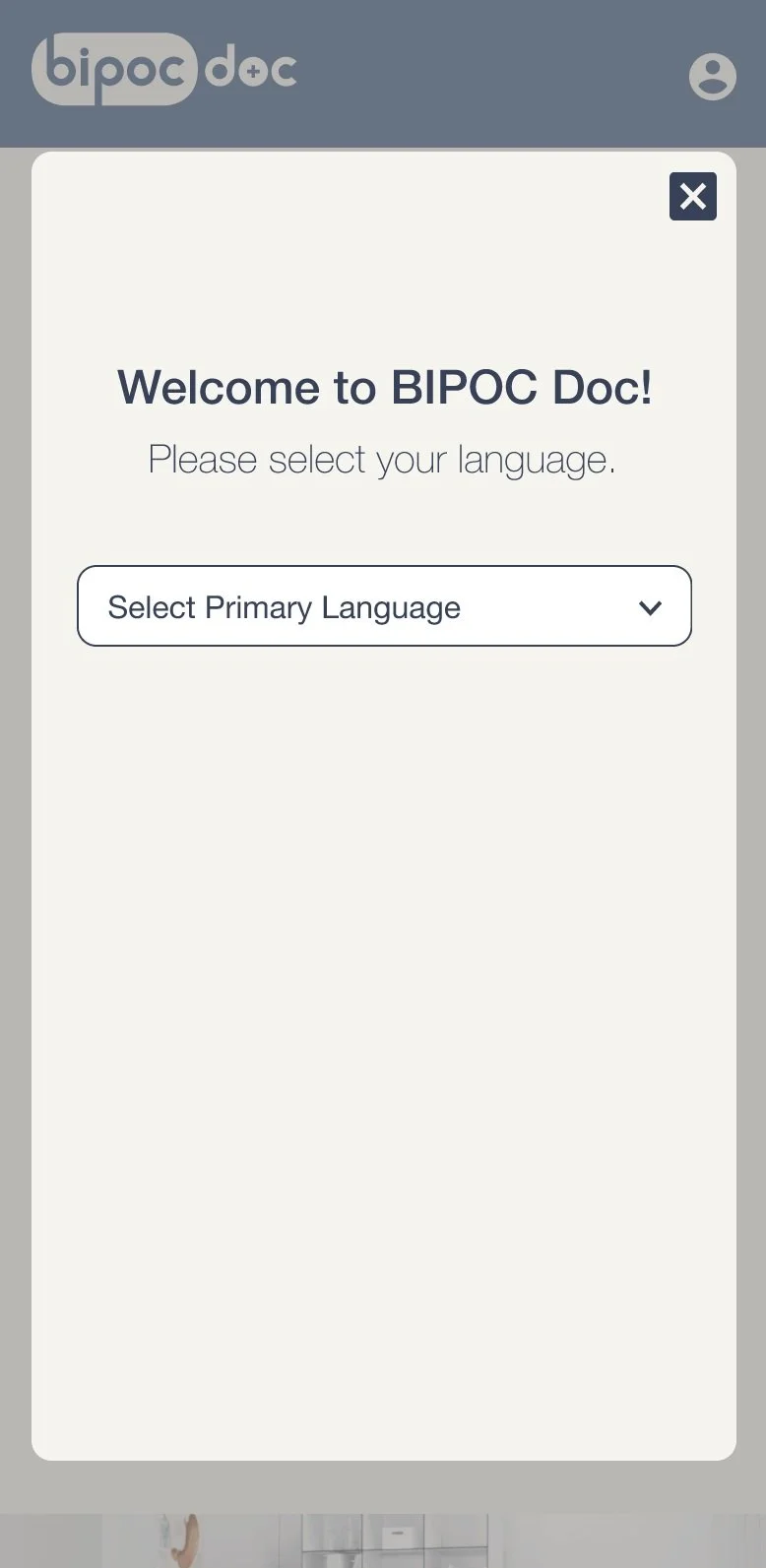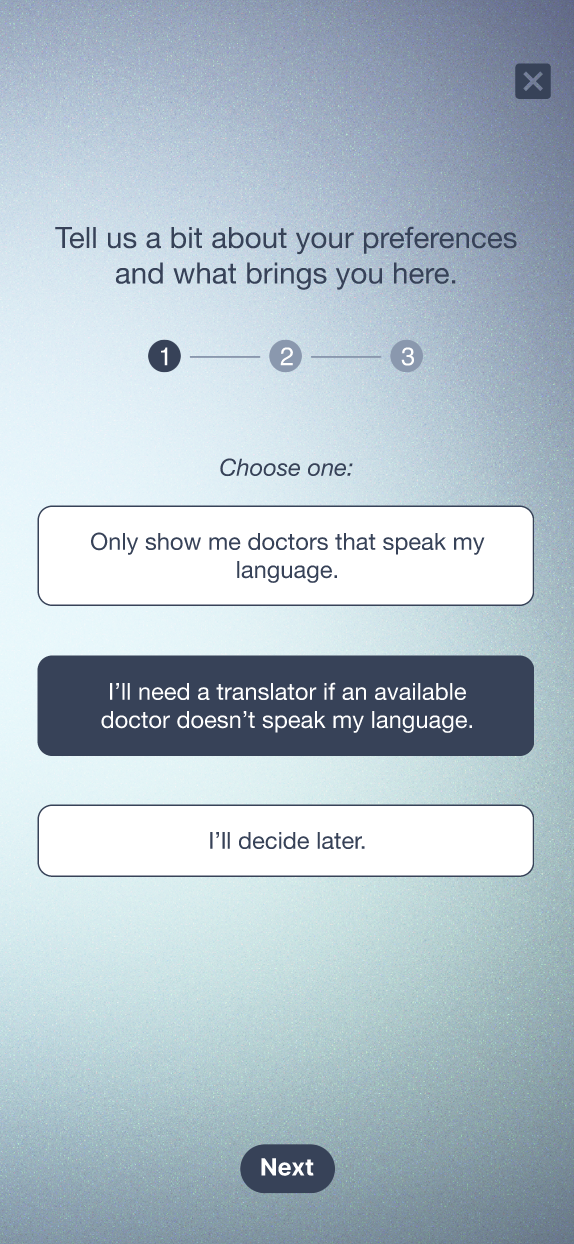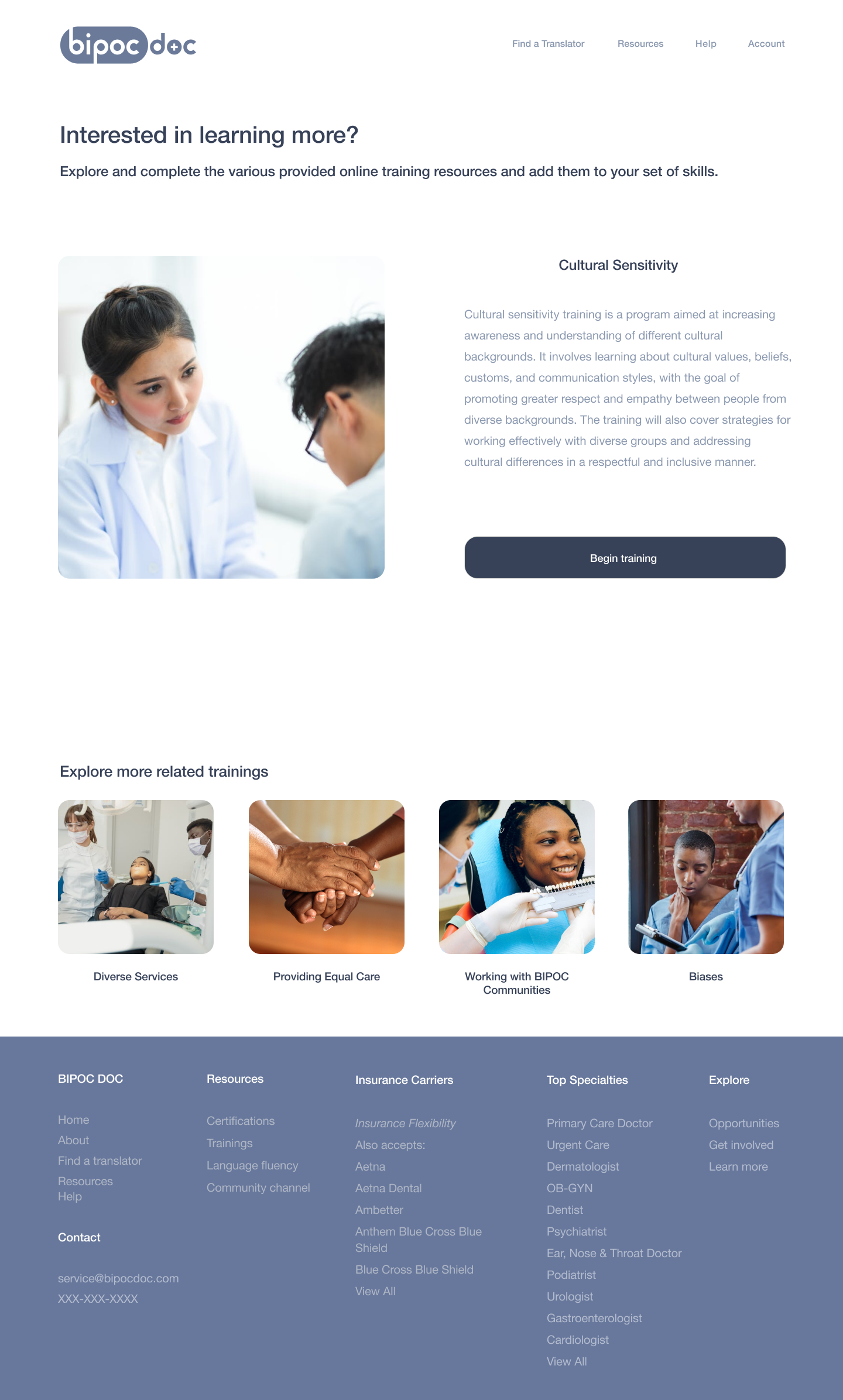BIPOC Doc
Full stack design for a healthcare platform catering specifically to the BIPOC community.
The Client: The Black Alumni Collective - a diverse group of educators and students dedicated to creating an equitable healthcare landscape for the BIPOC community. They approached us with a focus on developing a platform to address the unique needs of marginalized groups
The Team: 2 UX researchers and myself
Timeline: 5 weeks
Scope: High fidelity website prototype, mobile and desktop views
Project Context
Navigating the healthcare system is daunting for most, but especially for BIPOC individuals. Due to an array of access barriers, BIPOC communities not only receive less care than white individuals, they also receive worse care.
Overview
I worked on the research, user experience and visual design for this concept.
Problem 1 - Absence of bilingual doctors
+
Problem 2 - Scarcity of translators
+
Problem 3 - Lack of cultural awareness and empathy among providers
=
BIPOC individuals feel dismissed and disrespected by healthcare providers, leading to poor health outcomes.
Exploring the issue at hand
The problem
BIPOC individuals encounter barriers in healthcare due to inadequate support and methods that cater to their needs, such as; lack of bilingual doctors, limited website features, and insufficient cultural awareness among healthcare providers. Consequently, they often experience dismissive treatment and disrespectful attitudes, leading to compromised health outcomes.
The solution
We will create a BIPOC health service site that will connect users to skilled, multilingual, and culturally sensitive doctors. The platform will offer various healthcare features and train providers to be more aware of biases, culturally sensitive, and empathetic, ensuring respectful care for BIPOC individuals.
Research
In order for BIPOC Doc to be successful in catering to its diverse customer base, the team felt we needed to develop a better understanding of exactly who the potential user would be. Together, the team divided and conquered user interviews, C&C analysis, and market research.
1) User interview takeaways
In consolidating the interviews and affinity mapping key points, 8 major commonalities were revealed. We summarized these commonalities into ‘I’ statements. These elements were of constant focus during the design process.
BIPOC experienced doctors
“I think having a doctor who is experienced with BIPOC patients and is highly trained is just as important as having a doctor who is a part of the BIPOC community.”
2) C&C analysis takeaway
Next, comparative + competitive analysis of other industry competitors was performed to assess their products and services.
Health providers researched: Zocdoc, Blackdoctor.org, Indian Health Service, DocInfo, the VA
None of the providers do everything that BIPOC Docs wants to achieve. Zocdoc came the closest, but does not cater to theBIPOC community. This confirmed that there is indeed a market demand for BIPOC Doc.
3) Background research takeaways
The primary focus of the background research was to investigate the inequities within the U.S. healthcare system that have an adverse impact on individuals who identify as BIPOC. Of the many articles I read on the topic, this one sums it up well. Below are some of the biggest takeaways.
◦ Many minorities have low levels of trust in the health care system, expressing much less confidence in doctors and hospitals than white people.
◦ 70% of Black Americans and 43% of Hispanic Americans think that the US healthcare system treats people unfairly based on their race or ethic background.
◦ Disparities in quality of care have been attributed to factors such as poverty, discrimination, lack of access to care, and cultural barriers.
Now, meet 3 BIPOC Doc users.
The final personas highlight the different wants and needs that were used to target each of the different user groups.
ESL persona
Malena, a Spanish-speaker
Malena wants to find doctors who speak her language, or to have the ability to have a translator at the appointment with her. She wants her doctors to be familiar with her cultural background and trained on biases and cultural awareness.
This brings us to the design process.
At this stage, our team recognized the importance of highlighting the common goals from the persona exploration. To achieve this, we designed a homepage that offers a comprehensive overview catering to the needs of all users. This approach ensures that anyone visiting the site understands the functionality and benefits of using BIPOC Doc right away.
The below details basic customer journeys for each of the three personas.
Malena just wants to find and book an appointment with a primary care doctor who speaks Spanish.
Paul wants to find a reputable therapist who takes his insurance.
Dr. Lee wants to take a cultural awareness training program in order to be able to better provide for a broader patient base.
After finalizing the user flows, I created preliminary wireframes focusing on the onboarding pages and homepage, providing an initial glimpse of the site's functionality and layout.
Mobile view of the website (from a patient’s perspective)
popup onboarding when first-time user arrives at the homepage
user goes through onboarding and makes selections
user is prompted to save those preferences by making a profile
homepage is now tailored to the user’s preferences, and they can start searching for doctors
Desktop view of the website (from a doctor’s perspective)
doctor’s profile page (show’s overall rating, upcoming appointments)
page of training programs BIPOC Doc offers providers
user selects a training and reads more about it, has the option to begin the training
Developing an aesthetic
Before diving into structuring the site’s information and building the prototype, I prioritized establishing its visual branding. I aimed to create a calming visual aesthetic for BIPOC Doc, counteracting the unease often associated with healthcare, especially among the targeted user groups.
I came up with several logo options and color themes and asked the client to make the ultimate decision before finalizing the design system.
*winner!
The prototype
The final designs embody both our team's and client's creative aspirations for BIPOC Doc. The sleek and professional aesthetic we aimed for is reflected in the final designs, which we believe will resonate well with the target audience.
We made sure to keep the user's needs in mind at every step, resulting in a platform that's approachable and user-friendly for both patients and doctors alike. Our focus on creating a streamlined experience has made it easy for users to achieve their objectives with minimal effort.
Mobile view
Landing page
Booking an appointment
Landing page
Upon arriving at the website for the first time, the user is prompted to select their language. The website will then automatically translate to the chosen language.
Language selection
Onboarding
These screens are for the user to enter their preferences, including; what language they prefer their doctors to speak, their ethnicity and how important it is that their doctors are of the same, and what type of care they’ll be using BIPOC Doc to find. We were intending for these screens to pique a first-time user’s interest and really give them a taste of what BIPOC Doc can offer them.
Two of our primary users were using the website to find a doctor and book an appointment. Our Spanish-speaking persona was looking for a Spanish-speaking primary care doctor, options she chose in the onboarding - so, once she arrives at her personalized home screen, she will be served doctors that fit her preferences along with search options.
Notice the badges on the doctor's "card" that highlight their specialties and marketing points, such as certifications and languages spoken. BIPOC Doc enables doctors to feature up to 4 badges on their preview "card" visible to users before they click on the full profile, while they can display as many as they prefer on their complete profile.
Booking confirmation
A pop-up will be the final confirmation of the booked appointment, it will disappear after a moment and the user will be back on the homepage.
Desktop view
Profile page - doctor view
The user can see all their information in one place - rating, patients, licenses, upcoming appointments, etc.
BIPOC Doc-offered trainings
The site has built in trainings for a doctor to take and showcase on their profile, in addition to being able to showcase trainings and certifications received elsewhere.
Video demo of user 1 journey (patient view)
Video demo of user 2 journey (patient view)
Video demo of user 3 journey (doctor view)
A brief note on the usability testing
Feedback
We crafted three basic tasks, set a timer, and asked our users about the process along the way. Overall, the feedback we received was positive - we were told that it was a very streamlined process. Most mis-clicks occurred in places where the prototype just wasn’t built out yet. The over-arcing issues we discovered were as follow:
- gradient for onboarding screens was a little dark and could be an accessibility issue
- search box on the home screen for for entering time/location takes up a lot of space; would be better to see more doctors above the fold
- sideways scrolling is a little confusing, but would probably make more sense if there were more carousels below (which will come with building out the prototype more)
The mission of BIPOC Doc is to create a healthcare platform that is inclusive, equitable, and accessible to all members of the BIPOC community.
Through its network of culturally competent healthcare providers, BIPOC Doc will aim to address the disparities in healthcare access and outcomes that disproportionately affect BIPOC communities. The goal is to provide a safe and supportive space where patients can find the care they need to achieve optimal health and wellness.
Role
Looking back, looking forward
The BIPOC Doc project proved to be an enlightening experience that provided me with valuable insights into the fragmented nature of our healthcare system. Throughout the project, my team and I were able to gain a comprehensive understanding of the challenges faced by both patients and doctors due to the lack of awareness and equity in healthcare. Through active listening and empathetic engagement, we crafted a final product that reflects our unwavering commitment to our client and audience.
Our results showcase our team's focus and dedication to excellence, and our client was delighted with the outcome of the project. The next phase for our client involves presenting our research and prototype to potential investors to turn their vision for the site into a reality.
Moving forward, we are eager to expand our project and offer more features to the site, providing users with a range of helpful options. We aspire to enhance the doctor view of the site, offering more comprehensive training modules and other resources that can help doctors better communicate with ESL patients. Additionally, we plan to incorporate more interactive elements, such as collaborating with language development companies like Duolingo, Primsleur, and Babbel. By doing so, we hope to create a more inclusive and reliable healthcare service that meets the diverse needs of patients and doctors.
Empathy and understanding
“I need healthcare providers who are familiar with various ethnic backgrounds and can provide culturally sensitive care.”
Language barriers
“I feel dismissed and disrespected by healthcare providers due to language barriers and cultural backgrounds not being respected.”
Doctor training
“I think doctors need more training on biases, cultural awareness, and empathy to better understand their patients.”
Language and fluency
“I need doctors who speak my language because I find it difficult to understand medical terms that are not spoken in my first language.”
Translators
“I feel more comfortable when I have access to translators who can assist me during medical appointments.”
Navigation and booking
“I feel frustrated when trying to find a doctor and booking an appointment because there is no universal method that suits all my needs.”
Special features
“I need features on healthcare sites such as location, language, gender/cultural selection, insurance selection, appointment reminders, translator booking, and reviews.”
Black persona
Paul, a military veteran struggling with PTSD
Paul struggles with getting therapy through the VA - including but not limited to being mis-diagnosed, appointments being canceled, and outright denial of his mental health disability. Paul is seeking more dependable ways to find support, and just wants to find an empathetic therapist who can relate to him.
Physician persona
Dr. Lee, a physician
Dr. Lee is a compassionate and patient-focused physician who recognizes the importance of cultural awareness in her work. She wants a platform that can offer various resources and training to improve her cultural competency, and then be able to market this to her patient base.
